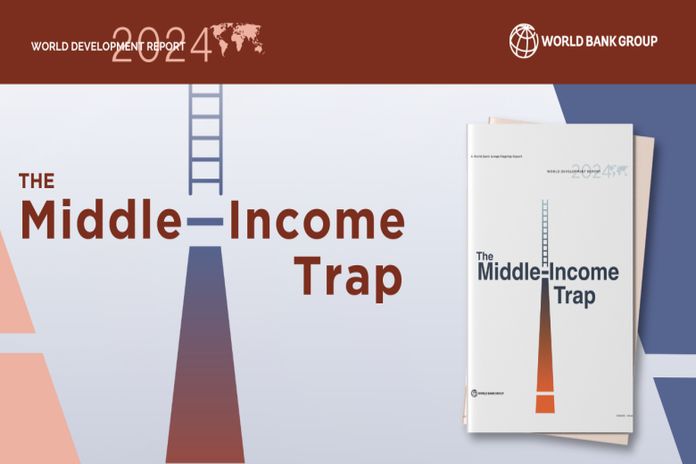- New research offers a 21st century playbook for high-quality growth
WASHINGTON, USA – More than 100 countries including China, India, Brazil, and South Africa – face serious obstacles that could hinder their efforts to become high-income countries in the next few decades, according to a new World Bank study that provides the first comprehensive roadmap to enable developing countries to escape the “middle-income trap.”
Drawing on lessons of the past 50 years, the World Development Report 2024: The Middle Income Trap finds that as countries grow wealthier, they usually hit a “trap” at about 10 percent of annual US GDP per person – the equivalent of $8,000 today. That’s in the middle of the range of what the World Bank classifies as “middle-income” countries. Since 1990, only 34 middle-income economies have managed to shift to high-income status -and more than a third of them were either beneficiaries of integration into the European Union, or of previously undiscovered oil.
At the end of 2023, 108 countries were classified as middle-income, each with annual GDP per capita in the range of $1,136 to $13,845. These countries are home to six billion people 75 percent of the global population and two out of every three people living in extreme poverty. They generate more than 40 percent of global GDP and more than 60 percent of carbon emissions. And they face far bigger challenges than their predecessors in escaping the middle-income trap: rapidly aging populations, rising protectionism in advanced economies, and the need to speed up the energy transition.
“The battle for global economic prosperity will largely be won or lost in middle-income countries,” said Indermit Gill, chief economist of the World Bank Group and senior vice president for development economics. “But too many of these countries rely on outmoded strategies to become advanced economies. They depend just on investment for too long – or they switch prematurely to innovation. A fresh approach is needed: first focus on investment; then add an emphasis on infusion of new technologies from abroad; and, finally, adopt a three-pronged strategy that balances investment, infusion, and innovation. With growing demographic, ecological and geopolitical pressures, there is no room for error.”
The report proposes a “3i strategy” for countries to reach high-income status. Depending on their stage of development, all countries need to adopt a sequenced and progressively more sophisticated mix of policies. Low-income countries can focus solely on policies designed to increase investment – the 1i phase. But once they attain lower-middle-income status, they need to shift gears and expand the policy mix to the 2i phase: investment and infusion, which consists of adopting technologies from abroad and spreading them across the economy. At the upper-middle-income level, countries should shift gears again to the final 3i phase: investment, infusion, and innovation. In the innovation phase, countries no longer merely borrow ideas from the global frontiers of technology, they push the frontier.
“The road ahead won’t be easy, but it’s possible for countries to make progress even in today’s challenging conditions,” said Somik V. Lall, director of the 2024 World Development Report. “Success will depend on how well societies balance the forces of creation, preservation, and destruction. Countries that try to spare their citizenry the pains associated with reforms and openness will miss out on the gains that come from sustained growth.”
South Korea is a standout example in all three phases of the 3i strategy, the report says. In 1960, its per capita income stood at just $1,200. By the end of 2023, that number had climbed to $33,000. South Korea began with a simple policy mix to increase public investment and encourage private investment. That morphed in the 1970s to an industrial policy that encouraged domestic firms to adopt foreign technology and more sophisticated production methods.
Korean companies responded. Samsung, once a noodle-maker, began manufacturing TV sets for domestic and regional markets. To do so, it licensed technologies from Japanese companies, Sanyo and NEC. Samsung’s success fueled demand for engineers, managers, and other skilled professionals. The South Korean government responded in turn. The ministry of education set targets and increased budgets for public universities to help develop the new skill sets demanded by domestic firms. Today, Samsung is a global innovator in its own right, one of the world’s two largest smartphone manufacturers.
Other countries followed similar paths including Poland and Chile. Poland focused on raising productivity with technologies infused from Western Europe. Chile encouraged technology transfer from abroad and used it to drive domestic innovation. One of its biggest successes involved adapting Norwegian salmon farming technologies to local conditions, making Chile a top exporter of salmon.





